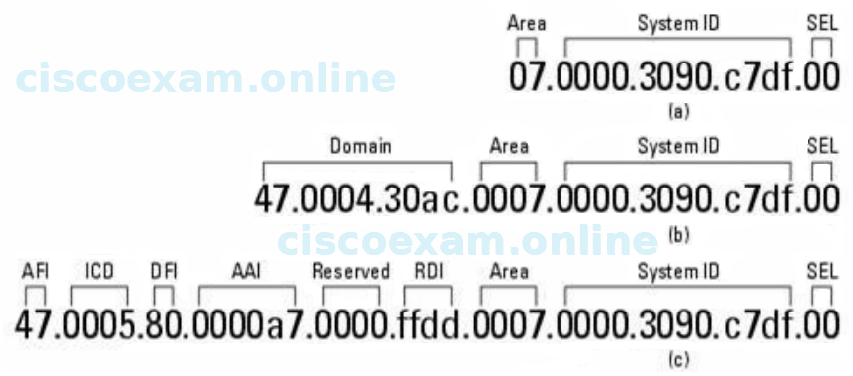Refer to the Cisco IOS XR configuration exhibit.
!
router isis 1
net 49.0001.0100.0200.1001.00
address-family ipv4 unicast
metric-style wide
address-family ipv6 unicast
metric-style wide
!
Which statement about the configuration is true?
| A. |
This is a Level-2-only router. | |
| B. |
This is a Level-1-only router. | |
| C. |
The maximum IS-IS path metric is 63. | |
| D. |
This router belongs to area ID 0001. | |
| E. |
This configuration is missing the net configuration for the IPv6 unicast address family. |
Three NSAP Formats:

AFI: Authority and Format Identifier
ICD: International Code Designator
DFI: Oomain Specific Part IDSP) Format Identifier
AAI: Administrative Authority Identifier
RDI: Routing Domain Identifier (Autonomous System Number)
SEL: Network Service Access Point (NSAP) Selector
If an official prefix is not required, you can use AFI 49, which denotes private address space, like IP address space for private Internets as defined in RFC 1918.
The AFI has a binary value between 0 and 99; this value specifies the IDI format and the DSP syntax. The DSP is in binary format, and the IDP is in decimal. ISO recognizes seven top-level network addressing authorities: each authority has its own addressing format represented by the IDI format field.
Cisco technology supports all NSAP formats that are defined by ISO 8348/Ad2.
It is possible to configure multiple NETs on a router, but no router is ever in more than one area. Configuring multiple NETs causes the areas to merge into a common area, leaking the Level 1 databases into each other. The only reasons to have multiple NETs are for splitting, merging, or renumbering areas; this method should only be used in periods of transition. Cisco Systems limits the number of configurable NETs to three per router.